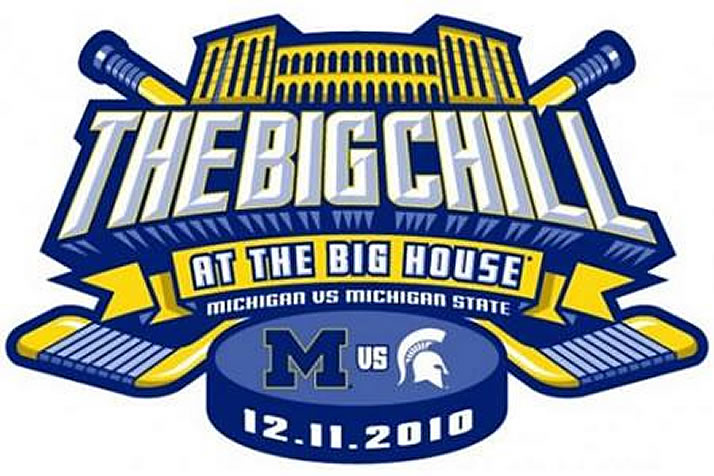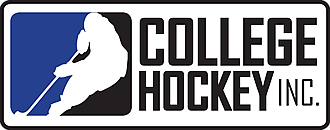Friday, December 10, 2010
USCHO Commentary on WSJ article on the mark

Commentary: Don’t be fooled into thinking outdoor games are key to growing college hockey
By Dave Starman – National Columnist – Thursday, December 9, 2010
The Big Chill.
The Big House.
The big misnomer.
A long-time subscriber to the Wall Street Journal, I almost choked on my breakfast reading the article on the outdoor game in Ann Arbor this weekend. I was never so excited to recycle a newspaper as I was after that read.
Talk about missing the point. To say that games like this are a way to sell college hockey, for it to reach a larger place in American sports, to reach its zenith in popularity is so misconstrued in its logic it is almost laughable.
There is no question in Ann Arbor that coach Red Berenson’s Wolverines are the best ticket in town; 20 straight years in the national tourney and all. The Wolverines are well represented in the NHL; it seems like every roster has a Berenson alum on it. A game at Yost Arena is a must-see for any sports enthusiast; it is just plain awesome. It is because it is inside. Michigan Hockey is Yost Arena and vice versa. It is not Michigan Stadium.
The story tried to sell us on the game Saturday being a shot in the arm for the selling of college hockey. I disagree. It does wonders for Michigan and Michigan State and is great for hockey fans in Southern Michigan and both programs, but what it does for college hockey is probably not much on the big scale.
How about some of the things that have done wonders for hockey in this country? The NHL in southern markets has been hit and miss, but in Southern California and Florida it has created a wave of players. California kids are sought after by the NCAA and major junior and are winding up in the NHL. Retired players are settling in non-traditional markets and helping to create great youth hockey programs that are developing NCAA players.
In a game within the last two NHL seasons, the San Jose Sharks boasted Douglas Murray and Ryan Vesce playing a game against the Pittsburgh Penguins. Rob Scuderi and Mark Eaton played for Pittsburgh. Those four were teammates on a junior team on Long Island before all were recruited to colleges (Murray and Vesce at Cornell, Scuderi at Boston College and Eaton at Notre Dame) and started playing in the NHL. That can be traced back to the New York Islanders’ success in the 1980s and the impact the Isles had on the Long Island hockey community and the ex-players who stayed there and started coaching.
Non-traditional markets becoming breeding grounds for players has done wonders for college hockey.
There is no question, as Hockey East commissioner Joe Bertagna pointed out, that players are coming to the NCAA to play hockey from markets that you would never have thought of 10 years ago. Cornell coach Mike Schafer said it best. At the Florida College Classic in 2004, he had a captain from Long Island in Vesce and a goalie from Dallas in David McKee. He said, “If you had told me that would be the case when I started coaching I would have said you were nuts.”
Then the author would have us believe that we’re lucky to have five schools that represent Big Ten institutions showing us the promise of what college hockey can be.
“Big Ten schools, and Michigan in particular, demonstrate the sport’s potential. The Wolverines draw near-sellout crowds at every home game at Yost Ice Arena,” the story reads.
Big Ten schools?
Really?
Show up in Orono, Maine, Friday night when New Hampshire visits Maine. Sellout? No question. The building will be packed by the start of warmups for what has been nicknamed “The Border War.” Described by coach Tim Whitehead as “our little Fenway Park,” Alfond Arena is an impossible ticket most weekends with students waiting at times overnight the night before camped out in the parking lot to get tickets. The same happens at Miami and North Dakota. No football stadium needed for these programs to demonstrate the sports potential.
The last three national championships have come from Hockey East. While there was an impressive run of Minnesota winning two and Wisconsin and MSU winning one each last decade, North Dakota, Boston University, BC, Maine and Denver are schools that demonstrate the sports potential because, outside of BC, they rule the roost on their campuses. Then again, BC has national titles in 2001, 2008 and 2010. Football and hoops haven’t come close in Chestnut Hill to matching that success.
Do packed buildings in Denver not show us the sports potential? The success of Denver and Colorado College and the recent emergence of Air Force as a pretty good program have done wonders for youth hockey in Colorado, and that state is now cranking out Division I-caliber players.
A Hockey East team has been in the national title game in 11 of the past 12 seasons, the exception being when Denver played North Dakota in 2005. Youth hockey up to junior hockey is rampant from Southern Maine all down the East Coast.
While Wisconsin and Michigan have arenas and atmosphere that rank in the upper tier of college hockey, “Big Ten schools” are not the be all and end all of college hockey, and to imply so is irresponsible or just uninformed.
BU-BC might be the best rivalry out there. Their outdoor game at Fenway was exciting but did very little to enhance the legend of the Battle of Comm Ave. The Beanpot does that; the Hockey East playoffs usually do that also. No other rivalry outside of maybe USC-UCLA boasts two programs with the great tradition of the Terriers and Eagles with their proximity to each other. They are three miles apart; you can take the subway to get from one arena to the other in about 15 minutes. Their coaches have been competing against each other since high school.
North Dakota-Denver, CC-Denver, and especially UNH-Maine are rivalries and programs that are every bit what the Big Ten schools offer. Minnesota hasn’t been relevant in a while, Ohio State hasn’t either. Penn State is years away from being a top program. Miami, Notre Dame, Minnesota-Duluth, St. Cloud State and Cornell all show the potential the sport has with the strength of their programs.
“Still, those close to college hockey understand that the sport hasn’t come close to its ceiling ? and isn’t likely to get there overnight,” the story reads.
The ceiling of college hockey does not rest in the members representing Big Ten institutions. It rests in the NCAA’s ability to convince student-athletes play college hockey. USA Hockey plays a role here and does it very well, as does College Hockey Inc., the marketing arm of NCAA hockey under the expert guidance of Paul Kelly. He is the former director of the NHLPA.
The ceiling of college hockey rests in its ability to attract quality players, players that are the future stars of the NHL. People in the U.S. watch college hoops and college football because they’ll watch these kids become the next wave of NFL and NBA stars.
College hockey generates a ton of real good players that make up 30 percent of NHL rosters. Most of the gold medal-winning United States World Junior team last year played U.S. college hockey. The key is the quality of the product, not if it’s played outdoors. Kelly is making sure north of the border that those elite kids know there is an elite development system in place here in the NCAA and the continued influx of those Grade A players will help increase popularity.
College hockey loses great underclassmen every year to pro hockey. Folks like Kelly and College Hockey Inc. have made it a priority to try and see if there can be successful dialogue between the NHL and NCAA programs that help keep the student-athlete in school the full four years to, A, help the player and, B, help college hockey be as entertaining as possible.
When we have to rely of gimmicks like an outdoor game every year to get attention, we are in deep trouble.
The game at Michigan Stadium Saturday is a nice event for people in Michigan. Michigan Stadium is a historical landmark in the state’s great sports history. The rivalry between U of M and MSU is terrific. It should be fun for the 110,000 who’ll be there.
Sunday, it will be over and what will have college hockey as a whole gained by it?
